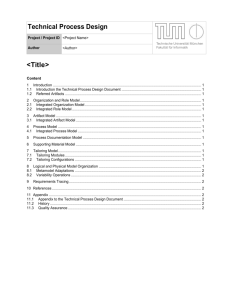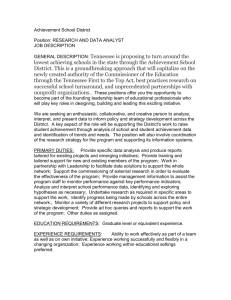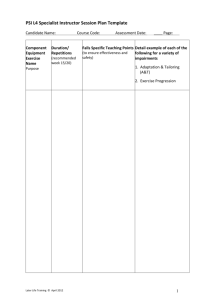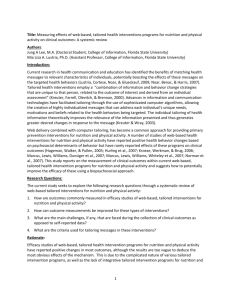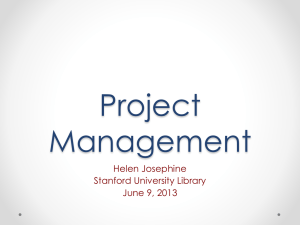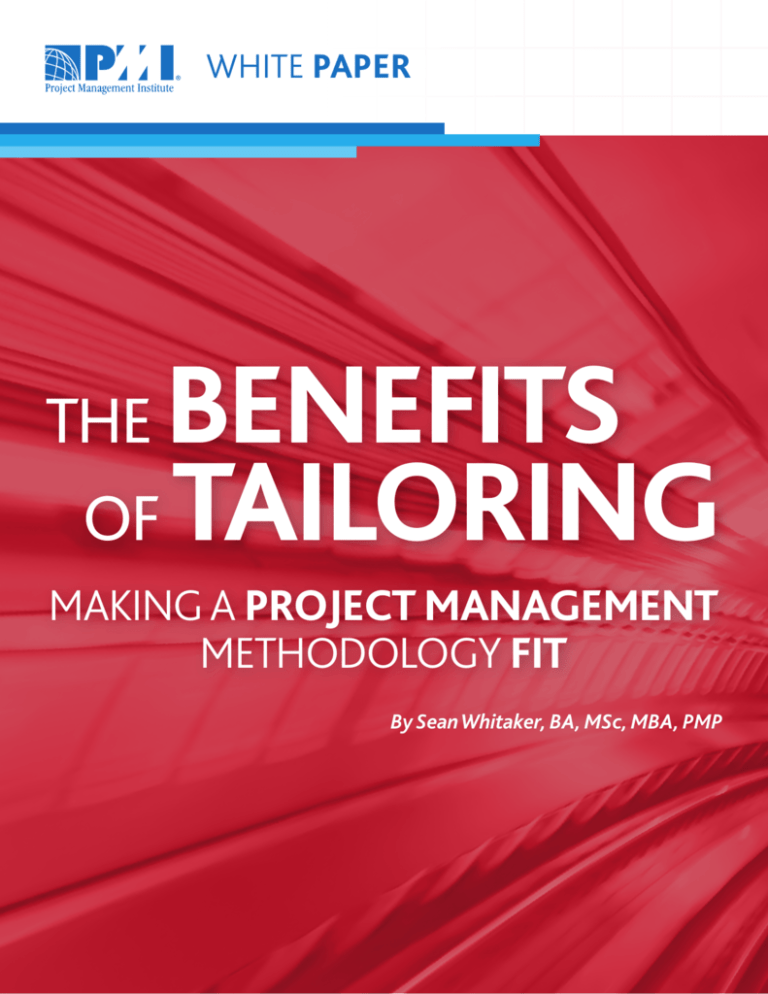
WHITE PAPER
THE
OF
BENEFITS
TAILORING
MAKING A PROJECT MANAGEMENT
METHODOLOGY FIT
By Sean Whitaker, BA, MSc, MBA, PMP
The Benefits of Tailoring: Making a Project Management Methodology Fit
Table of Contents
Introduction. . . . . . . . . . . . . . . . . . . . . . . . . . . . . . . . . . . . . . . . . . . . . . . . . . . . . . . . . . . . . . . . . . . . . . . . 3
Project Management Methodologies and Tailoring. . . . . . . . . . . . . . . . . . . . . . . . . . . . . . . . . . . . . . 4
How to Tailor a Project Management Methodology. . . . . . . . . . . . . . . . . . . . . . . . . . . . . . . . . . . . . . 6
Initial tailoring . . . . . . . . . . . . . . . . . . . . . . . . . . . . . . . . . . . . . . . . . . . . . . . . . . . . . . . . . . . . . . . . . . . . . . . . . . . . . . . . . . . . 7
Pre-project tailoring . . . . . . . . . . . . . . . . . . . . . . . . . . . . . . . . . . . . . . . . . . . . . . . . . . . . . . . . . . . . . . . . . . . . . . . . . . . . . . 11
Intra-project tailoring . . . . . . . . . . . . . . . . . . . . . . . . . . . . . . . . . . . . . . . . . . . . . . . . . . . . . . . . . . . . . . . . . . . . . . . . . . . . 11
Observations From the Field. . . . . . . . . . . . . . . . . . . . . . . . . . . . . . . . . . . . . . . . . . . . . . . . . . . . . . . . 12
Summary. . . . . . . . . . . . . . . . . . . . . . . . . . . . . . . . . . . . . . . . . . . . . . . . . . . . . . . . . . . . . . . . . . . . . . . . . 18
References. . . . . . . . . . . . . . . . . . . . . . . . . . . . . . . . . . . . . . . . . . . . . . . . . . . . . . . . . . . . . . . . . . . . . . . . 19
Appendix 1 - Project Management Methodology Checklist. . . . . . . . . . . . . . . . . . . . . . . . . . . . . . 20
Appendix 2 - Methodology Process Flow Chart. . . . . . . . . . . . . . . . . . . . . . . . . . . . . . . . . . . . . . . . 21
Appendix 3 - Data Collection. . . . . . . . . . . . . . . . . . . . . . . . . . . . . . . . . . . . . . . . . . . . . . . . . . . . . . . . 22
2
©2014 Project Management Institute, Inc.
September 2014
Introduction
With Implementing Organizational Project Management: A Practice Guide (PMI, 2014), practitioners have a broad
and general introduction to ways an organization can integrate its portfolio, program and project management
practices into its overall organizational management. A key part of this publication, chapter 5, How to Develop
a Tailored Organizational Project Management Methodology, presents a process to enable practitioners and
organizations to develop their own tailored methodology.
Many organizations have unsuccessfully tried to implement an off-the-shelf, or ready-made, project
management methodology and found that it was unsuitable for their particular projects, their organization, and
their level of organizational project management maturity. This often results in a lot of money, time and effort
spent with little return. While the original intent was an increase in successful projects, the actual outcome was
the opposite—often accompanied with a decrease in staff morale.
Before committing to any initiative to introduce a project management methodology, it is important to answer
the question, “Why have a methodology at all?” Furthermore, if an organization chooses to have a defined
methodology, why a tailored methodology and not an off-the-shelf methodology? Answering these questions
will reveal the link to more successful projects; and delivering projects more successfully is the goal of any
professional project management practitioner.
The PMI (2013a) Pulse of the Profession® report found that “organizations with developed project management
practices, benefits realization processes, portfolio management practices and program management practices
and those with high organizational agility all have significantly better project outcomes than their counterparts
who are less advanced in their project management practices” (p.11). This paper spotlights project management
methodologies tailored for organizational fit and examines how they are a key component of those effective
project management practices.
This paper proposes a model and process for the initial and ongoing tailoring of a project management
methodology. The goal is to enable organizations and project management practitioners to develop and tailor
their own project management methodologies to improve efficiency, effectiveness and the likelihood of project
success.
A secondary goal of this paper is to explore the links between project management methodologies and project
success. We conducted research that invited project management practitioners from a range of industries
to provide accounts of their experience with project management methodologies, project success and
organizational project management maturity. The second part of this paper presents the findings of this research
and reveals a link between a tailored project management methodology and the successful delivery of a project.
©2014 Project Management Institute, Inc.
3
The Benefits of Tailoring: Making a Project Management Methodology Fit
Project Management Methodologies and Tailoring
A Guide to the Project Management Body of Knowledge (PMBOK® Guide) (PMI, 2013b) defines a methodology
as “a system of practices, techniques, procedures and rules” (p. 546). More specifically, a project management
methodology is a defined, documented and discoverable set of policies, practices, processes, tools, techniques
and templates that provide guidance on how projects are run within an organization. A methodology can be
extensive or minimal; rigorous or lightweight; complex or simple; linear or highly iterative; described in phases or
described for the entire project lifecycle. There is no one, single project management methodology that should
be applied to all projects all of the time. A project management methodology should reflect the size, duration
and complexity of each individual project, and be adapted to the industry, organizational culture and level of
organizational project management maturity of the organization. A methodology is typically derived from a
project management framework document or standard such as the PMBOK® Guide.
Tailoring is the process of referencing framework documents, standards and other relevant sources and utilizing
those elements that provide processes, tools and techniques that are suitable for that particular organization. It
also includes modifying existing processes currently in use by the organization. As such, the process of tailoring
is a process of customizing a project management methodology. The result of tailoring is that the project
management methodology will be suitable for use in specific types of projects, and a tailored methodology will
reflect the size, complexity and duration of the project as appropriate for the organizational context along with
adaptation to the industry within which the project is undertaken.
General examples of tailoring include the trend for IT projects to use agile-based approaches, while construction
projects more often use a waterfall approach. Organizational culture is another dimension influencing tailoring.
An organization with a low tolerance for risk may have many processes and procedures to guide project
management throughout its lifecycle; while a similar company operating in the same market—but with a high
tolerance for risk—may have fewer processes and procedures. For example, in American Productivity & Quality
Center’s Effective Project Management Offices study (APQC, 2013), Dell Services, a business unit of Dell, Inc.,
reported using a four-level ranking system to categorize project complexity. At the highest level, projects use a
high degree of rigor. As the level of complexity decreases, so too does the level of rigor and level of monitoring.
Project performance is monitored using an established framework for consistent reporting across all projects.
The PMBOK® Guide (PMI, 2013b) points out that the process of tailoring is the responsibility of the project
manager when it says:
…[F]or any given project, the project manager, in collaboration with the project team, is
always responsible for determining which processes are appropriate, and the appropriate
degree of rigor for each process. Project managers and their teams should carefully address
each process and its inputs and outputs (p. 48).
The alternative to tailoring is an unmodified, off-the-shelf project management methodology. There are
many of these methodologies available and a simple online search reveals many types of ready-made project
management methodologies suitable for different types of projects. Often, they provide descriptions of
processes, phases, tools, techniques and templates to be used in projects, but are not customized to the
organizational context.
4
©2014 Project Management Institute, Inc.
September 2014
Most of these methodologies come with clear instructions that they should not be applied rigorously but should
be subject to a process of tailoring to determine which elements are most useful to the project manager given
the particular type, size and complexity of his or her project. Some inexperienced practitioners fail to understand
this and apply the methodology verbatim regardless of project size, complexity, duration or organizational
context. This very rarely leads to project success. However, the fault lies not with the methodology but with the
inappropriate application by the practitioner seeking an easy solution to managing his or her projects.
©2014 Project Management Institute, Inc.
5
The Benefits of Tailoring: Making a Project Management Methodology Fit
How to Tailor a Project Management Methodology
A tailored project management methodology produces direct and indirect benefits to organizations—generally,
the greater the level of project management methodology tailoring, the greater the level of project success.
Additional benefits of a tailored approach to a project management methodology include:
■■
■■
■■
More commitment from team members who helped to create it.
A customer-oriented focus; as the needs of the customer are an important influencing factor in its
development.
A more efficient use of project resources.
In the absence of an appropriately tailored project management methodology, individuals will tailor their own
solutions. Here are some signs that the methodology is not tailored correctly:
■■
■■
■■
■■
Project team members are not using the methodology and are managing projects without any structure
or uniform process at all.
Project team members are independently modifying the methodology without guidance and are
developing their own unique versions, eliminating the efficiencies gained by standardization.
The methodology features processes for the sake of process with little thought given to whether or not
they deliver benefits and contribute to project success.
It is a one-size-fits-all approach to projects of differing types, sizes and complexity.
Chapter 5 of Implementing Organizational Project Management (PMI, 2014) gives a broad outline of how to
develop a tailored organizational project management methodology. The nine-step process is categorized into
assessment, development and improvement phases as follows:
A. Assessment
1. Identify types of projects
2. Identify inputs
3. Identify constraints
4. Identify resources
B. Development
5. Develop and document the methodology
6. Derive output
C. Improvement
7. Conduct continuous improvement
8. Monitor key performance indicators
9. Repeat for each of the different types of projects
6
©2014 Project Management Institute, Inc.
September 2014
It is noted that this process can “be used with minor modifications to develop portfolio and program
methodologies” (PMI, 2014, p.64). These nine steps should not be seen as just a single, linear process, but a
process that is repeated at three distinct stages. These three interconnected stages are represented in Figure 1.
Stage 1:
Initial Tailoring
Stage 2:
Stage 3:
Pre-Project
Tailoring
Intra-Project
Tailoring
Figure 1: Three stages of tailoring a project management methodology
Many project management methodology development and implementation initiatives fail because issues
around successful organizational change management (OCM) were not considered. It is not enough to have
the best project management methodology in the world if it is not successfully implemented and continuously
improved. Successfully completing development, implementation and improvement of any methodology
initiative relies on the ability of the person or group responsible to be a successful change agent. There are
several very good models that describe successful OCM and it is recommended that any practitioner research
and apply them appropriately. An excellent place to start is Managing Change in Organizations: A Practice
Guide (PMI, 2013c), which “sets the practices, processes, and disciplines on managing change in the context of
portfolio, program, and project management, and illustrates how change management is an essential ingredient
in using project management as the vehicle for delivering organizational strategy” (p. 1).
Therefore, a complete model for tailoring a project management methodology should take into account the
steps to develop a project management methodology, a recognition of the three stages at which tailoring occurs,
and apply change management to ensure adoption, benefits realization and continuous improvement.
Initial tailoring
The first stage in developing a custom-fit methodology is the initial tailoring. This develops and selects
those processes, tools, templates, techniques and practices that will form the elements of an organizations’
particular baseline tailored project management methodology. Once this initial process is complete, a baseline
methodology is established. The value in doing this is that the organization has guidance that will deliver more
successful projects and real bottom-line value to the organization.
The checklist in Appendix 1 provides guidance on potential topics or areas for which to develop material when
deciding what to include or exclude in the initial development of the tailored project management methodology.
The list is not intended to be exhaustive, but provides a good starting point.
©2014 Project Management Institute, Inc.
7
The Benefits of Tailoring: Making a Project Management Methodology Fit
The development of the project management methodology is a project in itself. As such, a project manager
should be appointed to lead this effort, and a team identified to support it. Buy-in to the final methodology is
increased when input from the entire team is included. This will create champions and supporters for the project
management methodology once it is developed and aid in its adoption, use and improvement.
As with any other project, the decision to embark on this effort should begin with some form of justification,
which should include a description of the expected benefits. Having a documented list of expected benefits will
be extremely useful when assessing whether or not the methodology is working as planned.
As mentioned earlier, the steps to successfully developing a tailored methodology are grouped into the three
areas of assessment, development and improvement. The following elaborates on the nine steps in these three
groups and describes the activities to be completed.
A. Assessment
The assessment processes seek to measure the current level of project management maturity, and define
the desired level within the organization. The purpose of this exercise is twofold: First, to get a picture
of where the organization is now, and where it should be in relation to project management maturity
and capability; Second to provide a benchmark against which future change (hopefully improvements)
can be measured. There are a number of organizational project management maturity models available
including OPM3® (PMI, 2013d). Additionally, PMI’s Standards Navigator® provides guidance in
developing a methodology using PMI standards.
1. Identify types of projects: Identify and describe the types of projects the organization undertakes;
including information about the size, complexity, duration and any other relevant issues. A project
profile assessment is described in Implementing Organizational Project Management (PMI, 2014) and
can be downloaded from www.pmi.org/methodology in the tools and templates section.
2. Identify inputs: Identify and collate all of the available inputs, including existing organizational
process assets and all existing templates, software, processes, user manuals and other supporting
material. Complete an inventory of what already exists to avoid reinventing the wheel. A good idea
is to gather project management practitioners and project team members together and spend
some time mapping out the process for how projects should work. Make note of the milestones,
documents, processes and other elements that occur at different stages. Note any duplicate
templates, processes or other elements. Choose which tools, templates and processes best suit the
purpose. Compare what input is currently available to the process map of how projects work and
identify any gaps in inputs.
Also take into account any enterprise environmental factors, organizational culture and the particular
organizational structure within which the project will be delivered. Each of these inputs will influence
the extent of, and type of, tailoring.
3. Identify constraints: Identify and document constraints to the methodology, including financial
constraints or national, local, or industry-specific regulations that the project management
methodology must take into account.
8
©2014 Project Management Institute, Inc.
September 2014
4. Identify resources: Identify the existing sources of information and guidance available, including
sources such as:
––
––
––
––
––
––
––
––
––
––
Standards (i.e. ISO21500: Guidance on Project Management [ISO 21500:2012]);
Framework documents (i.e., the PMBOK® Guide (PMI, 2013b));
Existing proprietary methodologies and approaches (i.e. Method123, TenStep, Prince2, Scrum,
Crystal, XP);
Methodologies used by others in the same industry;
Professional project management associations (i.e. PMI);
Professional project management communities (i.e. Agile Manifesto for IT Projects);
Consultants;
Project management practitioners;
Users of the project management methodology; and
Stakeholders actually or potentially affected by the project management methodology.
B. Development
5. Develop and document the methodology. Build the methodology iteratively by using project
management practitioners and project team members to document resources such as a process
flow chart, user guides, standardized templates, lexicons, tools, techniques and other aspects of
the methodology. Don’t worry about building everything right away; focus on the most important
aspects first. Then, take into account the size of the organization, the size and types of projects
undertaken, the organizational and project team culture, the range of complexity of projects, the
project duration, and the level of organizational project management maturity.
As a broad overview, start by developing an outline or process flow chart using the Plan-Do-CheckAct cycle, or the PMBOK® Guide (PMI, 2013b) process groups of: initiating; planning; executing;
monitoring and controlling; and closing to define major parts of the process.
In addition to the checklist of possible methodology elements contained in Appendix 1, Appendix 2
has a generic project management methodology process flow chart, which may be useful as a starting
point.
There are many excellent resources available to help develop the templates needed including A
Project Manager’s Book of Forms, 2nd Edition: A Companion to the PMBOK® Guide, 5th Edition (Snyder,
2013).
6. Derive output. The output derived from this process is the documented, discoverable, tailored project
management methodology ready to be used across the organization. Make sure everyone knows
where to find the elements of the new methodology. There have been instances of organizations with
methodologies stored away that nobody knew existed.
Once the methodology has been documented, go ahead and use it as planned. Note whether it is
working as expected and be prepared to make changes to improve its suitability.
©2014 Project Management Institute, Inc.
9
The Benefits of Tailoring: Making a Project Management Methodology Fit
C. Improvement
7. Conduct continuous improvement. A commitment to continuous improvement is one of the
hallmarks of a high level of organizational project management maturity. In order to carry out any
activities associated with continuous improvement, an organization needs to have resources devoted
to the task. Normally these resources are found within a project management office or center
of excellence. The process of continuous improvement includes audits to ensure that the project
management methodology is being used as intended—including the method for tailoring to specific
needs of the project—and that it is contributing to an increased level of project success. The audits
will reveal opportunities for continuous improvement as well. Update the methodology as required.
8. Monitor key performance indicators. Improvement also includes an assessment that the project
management methodology itself is delivering the benefits expected. These benefits and key
performance indicators should have been outlined in the initial project business case. Now they
should be revisited and the actual results measured against the forecasted results.
9. Repeat for each of the different types of projects. The final step utilizes the initial tailored project
management methodology and further customizes it for different project types the organization is
delivering. The pre-project tailoring also includes customizing or tailoring a project management
methodology, not just for types of projects, but for each individual project.
It may be that tailoring means the
development of distinct and separate
methodologies for use on different projects
that the organization delivers; therefore, it
would be prudent to also develop a project
management methodology selection matrix
to determine which of the methodologies
should be used on which project. Figure 2
shows an example of a project management
methodology selection matrix where there
are four different methodologies and each is
tailored to suit a project of different levels of
financial value and complexity.
Project Value
If the organization’s projects are largely similar, then chances are there will be a single, standardized
methodology that will be used without much change. If, however, the size and complexity of the projects varies
considerably, then this first stage will result in a scalable and flexible methodology that can be adapted to be
used on all projects. If this is the case, then a written description of how and under what circumstances the
methodology should be tailored would be useful to those using it to run their projects.
Simple
Methodology
Complex
Methodology
Very Simple
Methodology
Medium
Methodology
Project Complexity
Figure 2: Project management methodology selection matrix
10
©2014 Project Management Institute, Inc.
September 2014
Pre-project tailoring
The second stage in tailoring recognizes that in addition to the efforts involved in tailoring a comprehensive
baseline project management methodology for the organization, there must also be tailoring to individual
projects—not just types of projects. This involves selecting the processes, tools and templates that are applicable
to the project at hand. This works best when the baseline methodology includes guidance on how to further
customize it, including a checklist of compulsory and optional elements. This process is not about adding in new
or unique elements, but is instead about refining the existing baseline methodology to more perfectly suit each
project.
A central concept to the idea of tailoring is that it must be fit for purpose. Prior to using the project management
methodology on any specific project, a project manager should take responsibility for tailoring it even further
to suit his or her project. The second stage is the tailoring done before starting a project to determine what
elements of the project management methodology should be used. This process should involve both the project
manager and the project management office (PMO). In the absence of a PMO, the project sponsor should decide
which elements are appropriate for the particular project. An easy way to do this is to classify projects as: very
simple; simple; medium; and complex using a matrix similar to Figure 2. Then, have a checklist to identify the
different sets of processes, tools and templates for each category.
Intra-project tailoring
The third stage reflects and confirms the customizing nature of tailored project management methodologies
throughout the project lifecycle. This intra-project tailoring is completed throughout the project lifecycle by
checking that the particular combination of elements selected is still appropriate and the project is not being
over- or undercooked. Tailoring is an iterative process done throughout the entire project lifecycle. The PMO,
if one exists, should have an input into this review process and oversee and approve any changes. Capturing
lessons learned about the application of the selected methodology helps other project managers in the future.
By using these nine steps in three stages and organizational change management practices, a project
management practitioner can successfully deliver a tailored project management methodology including
processes, templates, tools, techniques and user guides.
©2014 Project Management Institute, Inc.
11
The Benefits of Tailoring: Making a Project Management Methodology Fit
Observations From the Field
Completely Tailored
7%
No
Methodology
Mostly
Tailored
42%
37%
11%
Moderate
Tailoring
Minor
Tailoring
3%
Figure 3: Does your organization have a defined
project management methodology?
No
29%
Yes
71%
Figure 4: Do you think a project management
methodology would help you deliver projects more
successfully?
12
We conducted a convenience survey of project management
practitioners to gauge their use and experience in utilizing
tailored project management methodologies. We asked a
variety of questions that sought to determine whether or
not they used a project management methodology, the
level of tailoring, the level of project success and the level of
organizational project management maturity. (See Appendix 3
for details regarding the research.)
The first question asked whether or not the respondents’
organization had a defined project management methodology.
Figure 3 shows that 42% of organizations do not have any
form of defined project management methodology. This
means that there were no standardized processes, templates,
tools or techniques. In contrast, a total of 58% of respondents
used some form of defined—and to a greater or lesser degree—
tailored, project management methodology.
Of the 58% of respondents who indicated that they used
some sort of defined project management methodology,
well over half of them drew inspiration from a ready-made
methodology, but had mostly built and tailored it themselves.
This is an important point to remember: development of a
tailored project management methodology does not need to
begin from scratch.
Respondents who indicated that they had no project
management methodology were asked whether or not
they believed one would help them deliver a project
more successfully. Somewhat surprisingly, 71% of them
indicated that they thought a defined project management
methodology would help them deliver their projects more
successfully, as shown in Figure 4. This may indicate that
while individual practitioners see benefit in a defined project
management methodology, the organizational culture and
senior decision makers do not see this benefit. It suggests that
successfully implementing a defined project management
methodology requires support from a wide range of
stakeholders including practitioners, executives, senior
technical staff and others who can influence its adoption and
use. A starting point may be to use research, such as presented
here, that demonstrates the benefits a defined and tailored
project management methodology brings to an organization.
©2014 Project Management Institute, Inc.
September 2014
Other sources of research demonstrating the general and specific benefits of project management practices
include the PMI Pulse of the Profession® report (PMI 2013a), and Researching the Value of Project Management by
Thomas and Mullaly (2008).
One of the reasons given for not having a project management methodology—and particularly a tailored project
management methodology—was respondents did not know how to develop and implement one, as reported by
just under 30% of the respondents who indicated that they did not have a project management methodology.
When asked the main reasons they did not have a project management methodology, the respondents provided
the responses shown in Figure 5.
37%
32%
31%
29%
17%
Our projects are
too unique to
have a defined
methodology
Our projects are
too small to have
a defined
methodology
We prefer an
ad-hoc approach
to managing
projects
We don’t know
how to build a
methodology
It is too
complicated or
costly to develop
or buy a project
management
methodology
Figure 5: Why do you not have a defined project management methodology?
From this information it can be seen that practitioners who do not use a defined project management
methodology do so predominantly because they believe their projects are either too unique or too small. This
implies that for each project they are undertaking, they are inventing their own unique set of tools, templates,
processes and documents to help manage their projects and, as a result, there is little or no standardization
across the organization.
It is doubtful that there are many projects so truly unique that they must have one-off sets of tools, templates,
and processes developed that are never used again. There is also no project too small that it cannot benefit from
standardized basic elements of a project management methodology. Small projects require small methodologies
that are tailored to provide benefits that exceed the costs incurred in developing them.
Therefore, all projects, regardless of how unique or small they are, should have the basic management processes
defined and documented. These basic, essential elements should include some form of project justification,
some way of defining the scope of work to be completed and some way of managing changes to the project.
Defining each of these three basic elements constitutes a minimalist project management methodology—but
still a defined project management methodology along with reusable tools and templates.
©2014 Project Management Institute, Inc.
13
The Benefits of Tailoring: Making a Project Management Methodology Fit
When asked about the impact practitioners
thought their methodology had on the success or
failure of their projects, only 2% of respondents
who indicated they used a defined project
management methodology indicated that it
played no role at all in whether the project
succeeded or failed. Figure 6 shows that 65%
of respondents who use a project management
methodology believe that a methodology plays
a major role in determining project success or
failure.
2%
8%
25%
Respondents were asked to provide a selfevaluation of project success, which was measured
against whether or not they had any form of
methodology; and, if they did, how much tailoring
or customization was done to it. The data shown
in Figure 7 indicates that having a tailored project
management methodology of any sort may be
related to greater levels of project success than
not having a project management methodology.
Furthermore, the data suggest that the more
tailoring of a project management methodology,
the greater the level of project success.
65%
A methodology
plays a major role
in determining
project success or
failure
A methodology
plays a minor role in
determining project
success or failure
Figure 6: How much does your project management
methodology contribute to the success, or failure, of your
projects?
67%
73%
68%
73%
82%
No Methodology
Minor Tailoring
Moderate Tailoring
Mostly Tailored
Completely Tailored
Figure 7: How often are your projects successful?
14
A methodology
plays no role at all
in whether or not a
project will succeed
or fail
Project success or
failure depends
entirely on the
methodology
being used
©2014 Project Management Institute, Inc.
September 2014
When the respondents were asked to assess the level of organizational project management maturity of their
organizations, there appears to be a relationship between those with no methodology compared to those
with a defined methodology. As Figure 8 shows, those organizations that used a defined project management
methodology reported a higher level of maturity than those organizations that did not.
5
Maturity Level
4
3
2
1
No
Methodology
Minor
Tailoring
Moderate
Tailoring
Mostly
Tailored
Completely
Tailored
Figure 8: How mature is your organization in relation to professional project management practices?
When asked whether or not their organization had a PMO, there was a difference between those organizations
that did not have a project management methodology and those that did. Figure 9 shows that 78% of
organizations with no project management methodology had no PMO at all. It also shows that of those
organizations with some form of tailored project management methodology, 65% have a PMO.
Organizations with no project
management methodology
Organizations with a project
management methodology
Yes
22%
No
35%
No
78%
Yes
65%
Figure 9: Do you have a PMO?
©2014 Project Management Institute, Inc.
15
The Benefits of Tailoring: Making a Project Management Methodology Fit
Project Management
Maturity
PMO
The existence of a PMO is an important consideration because
the development, implementation, use and improvement
of any project management methodology are important
responsibilities of a PMO—whatever form it takes within
the organization. This data suggests that the absence of a
PMO often has an adverse impact upon an organization’s
project management methodology.
Figure 10 shows a graphical representation of the way
in which a project management methodology would
normally be found within a PMO—which itself is often
a sign of project management maturity. However, the
organization’s level of project management maturity may
dictate what type of PMO the organization has and whether
or not the organization has any form of defined project
management methodology.
Project Management
Methodology
Figure 10: The relationship between project
management methodologies, a PMO, and organizational
project management maturity
16
©2014 Project Management Institute, Inc.
September 2014
Figure 11 shows the areas of project-related activities included in the respondents’
project management methodology for those respondents who indicated that
their organizations had some form of one and who indicated that their projects
were successful more than 75% of the time. These activities, along with the list in
Appendix 1, form a fairly comprehensive set of areas to consider when developing
a tailored project management methodology.
91%
Scope estimating,
management and
control
87%
82%
80%
80%
78%
Schedule
estimating,
management
and control
Project status
reporting
Managing project
changes
Cost estimating,
management
and control
Project phases,
stage gates and/or
milestones
73%
71%
66%
60%
60%
Project
communications
Project or phase
closure
Project risk
assessment,
management
and control
Quality assurance
Project
governance
58%
56%
54%
51%
47%
Gathering of
lessons learned
Quality control
Stakeholder
identification and
management
Procurements
and contract
assessment and
management
Benefits
realization or post
implementation
review
47%
42%
40%
36%
35%
Project team
formation and
development
Project charter
preparation
Project
sponsorship
Business case
preparation
Project selections
Figure 11: In which of the following areas does your project management methodology provide guidance?
©2014 Project Management Institute, Inc.
17
The Benefits of Tailoring: Making a Project Management Methodology Fit
Summary
Industry research suggests that there is a direct relationship between a tailored project management
methodology and project success. Undertaking the development of a tailored project management
methodology using the model presented here, and based on the processes outlined in Implementing
Organizational Project Management: A Practice Guide (PMI, 2014), can improve the efficiency and consistency
of project execution and improve project success. This is especially relevant to practitioners who do not have
a project management methodology because they don't know how to build one. The model provides guidance
to assist project management practitioners in building and improving their own tailored project management
methodology.
The data from the survey seems to support the conclusion that there is a benefit to organizations for
implementing a tailored project management methodology and suggests that the greater the level of project
management methodology tailoring, the greater the level of project success. Using the data gathered, the
following key points were observed:
■■
Approximately 40% of organizations manage their projects with no defined project management
methodology.
■■
Projects managed without a defined project management methodology reported project success
only 66% of the time while projects managed with a defined project management methodology
reported project success at an average of 74%; while organizations using a fully tailored, or customized,
methodology reported an 82% project success rate.
■■
Over 70% of project management practitioners working without a defined project management
methodology believed a defined project management methodology would help them deliver projects
more successfully.
■■
65% of organizations with a defined project management methodology reported having a PMO.
The data presented suggests that there is a relationship between the presence of a defined project management
methodology, and the degree of tailoring of that project management methodology, and project success. A
defined project management methodology tailored to suit the size, complexity, duration and organizational
context, as well as the organization’s industry, can contribute to a higher level of organizational project
management maturity and, as such, either directly or indirectly contribute to higher levels of project success.
18
©2014 Project Management Institute, Inc.
September 2014
References
APQC. (2013). Effective project management offices. Houston, TX: American Productivity & Quality Center.
ISO 21500:2012. Guidance on project management. Geneva, Switzerland: International Organization for
Standardization.
PMI. (2013a) Pulse of the profession: The high cost of low performance. Newtown Square, PA: Project
Management Institute.
PMI. (2013b). A guide to the project management body of knowledge (PMBOK® Guide)—Fifth Edition. Newtown
Square, PA: Project Management Institute.
PMI. (2013c). Managing change in organizations: A practice guide. Newtown Square, PA: Project Management
Institute.
PMI. (2013d). Organizational project management maturity model (OPM3®)—Third Edition. Newtown Square, PA:
Project Management Institute.
PMI. (2014). Implementing organizational project management: A practice guide. Newtown Square, PA: Project
Management Institute.
Snyder, C. S. (2013). A project manager’s book of forms, 2nd edition: A companion to the PMBOK® Guide, 5th
edition. Hoboken, NJ: John Wiley & Sons.
Thomas, J. and Mullaly, M. (2008). Researching the value of project management. Newtown Square, PA: Project
Management Institute.
©2014 Project Management Institute, Inc.
19
The Benefits of Tailoring: Making a Project Management Methodology Fit
Appendix 1 - Project Management Methodology
Checklist
Use this checklist to determine which elements the tailored project management methodology should have.
Project selection, justification and approval
process
Project communications development,
distribution and control
Project phases, stage gates and/or milestones
Project governance
Stakeholder identification, engagement and
management
Project sponsorship
Customer engagement and management
Delegated authority limits
Procurement and contract assessment and
management
Project roles and responsibilities
Vendor management
Business case preparation
Claims administration and resolution
Project charter preparation
Project management software selection
Requirements definition, management and
control
Health and safety
Environmental management
Deliverable acceptance procedure
Work breakdown structure development and
control
Operational handover process
Scope definition, management and control
Gathering, documenting and evaluation of
lessons learned
Cost estimating, management and control
Project, or phase, closure process and checklist
Benefits realization and/or post
implementation review process
Budget development and control
Project financial processes
Schedule estimating, management and control
Monitoring project performance, metrics/KPIs,
reporting
Methodology tailoring guidelines
Project change management
Project complexity assessment
Form templates
Managing project scope changes
Project status reporting
Quality assurance processes
Process audit procedures
Quality control processes
Risk assessment, management and control
Resource estimation, leveling and management
Project team formation and development
20
©2014 Project Management Institute, Inc.
September 2014
Appendix 2 - Methodology Process Flow Chart
Use this example process flow chart as a guide to develop the project management methodology process flow
chart for the organization.
P5: Report
Progress:
P4: Check and
Control Changes:
Produce project
reports detailing how the
projectis progressing
against planned metrics.
Check that what you
planned to do matches
what you are doing. Act
according to documented
change control process if
they don’t match.
Output: Project status
reports.
P1: Project Selection
and Justification:
Output: Corrective
actions, change requests,
project plans, baseline,
and document
updates.
P2: Project
Planning:
P3: Execute
the Plans:
Choose the right projects
for the right reasons.
Document expected
benefits.
Complete the right amount
of planning in all the
appropriate and relevant
areas. Replan as required.
Output: Business case,
project charter, work order,
project approval
documents, etc.
Output: Project
management plan,
individual plans, baselines,
project documents.
Project
Approval
P6: Close
the Project:
P7: Benefits
Realization:
Carry out the work
described in the various
planning documents.
Complete project closure
according to the planned
checklist.
Output: Project and
product deliverables
described in the plans.
Output: Project and product
acceptance, lessons
learned.
Examine and document
outcomes and benefits
delivered. Do they match
the original intended
benefits?
©2014 Project Management Institute, Inc.
Final
Deliverables
Output: Benefits realization
report, post implementation
review, continuous
improvement.
21
The Benefits of Tailoring: Making a Project Management Methodology Fit
Appendix 3 - Data Collection
Data for this whitepaper were collected via an online survey among project practitioners using a series of
questions focused on project management methodologies. A total of 202 respondents completed the survey.
Respondents came from a wide variety of industries and were at different stages of their project management
careers.
Figure 12 shows the distribution of industries and Figure 13 shows the range of project management roles held
by respondents.
11%
Healthcare and Pharmaceuticals
Government
10.25%
Construction, Machinery and Homes
10.25%
7.75%
Nonprofit
6.25%
IT Systems and Hardware
Utilities, Energy and Extraction
6.25%
Education
6.25%
Business Support and Logistics
Manufacturing
4.25%
3.5%
Communications, Technology and Electronics
3%
Software Development
3%
Retail and Consumer Durables
3%
Finance and Financial Services
1.25%
Airlines and Aerospace (including defense)
1.25%
Agriculture
1.25%
Figure 12: What industry do you work in?
22
©2014 Project Management Institute, Inc.
September 2014
26.5%
Senior Project Manager (more than 5 years experience
16.5%
Program Manager
12.5%
Intermediate Project Manager (less than 5 years experience
11.5%
Project Director
11%
Project Coordinator
C-Level Executive (i.e. CEO/CFO/COO/CIO)
5.5%
Technical Expert
4%
Project Administrator
4%
Project Support Staff
3.5%
2.5%
Head of PMO
Contract Manager
Project Expeditor
1%
<1%
Figure 13: What is your current role?
©2014 Project Management Institute, Inc.
23
Beijing | Bengaluru | Brussels | Buenos Aires | Dubai | Lelystad | Mumbai | New Delhi
Philadelphia | Porto Alegre | Rio de Janeiro | Shenzhen | Singapore | Washington, DC
PMI.org
Project Management Institute
Global Operations Center
14 Campus Blvd
Newtown Square, PA 19073-3299 USA
Tel: +1 610 356 4600 | Fax: +1 610 356 4647
E-mail: customercare@pmi.org
©2014 Project Management Institute. All rights reserved. “PMI”, the PMI logo, “Making
project management indispensable for business results” and Pulse of the Profession
are marks of Project Management Institute, Inc. For a comprehensive list of PMI marks,
contact the PMI legal department. BRA-124-2014 (09/14)
Making project management
indispensable for business results.®

